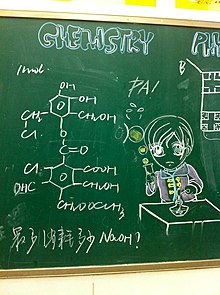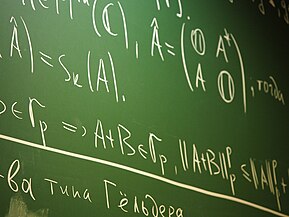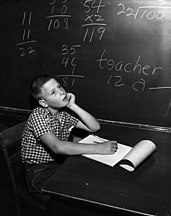Blackboard
 NASA scientist Homer E. Newell Jr. explaining principles of altitude, pressure, and temperature, c. 1973 | |
| Other names | Chalkboard, writing-board |
|---|---|
| Uses | Reusable writing surface on which text or drawings are made |
A blackboard or a chalkboard is a reusable
Design

A blackboard can simply be a board painted with a dark
A more modern variation consists of a coiled sheet of plastic drawn across two parallel rollers, which can be scrolled to create additional writing space while saving what has been written. The highest grade blackboards are made of a rougher version porcelain enamelled steel (black, green, blue or sometimes other colours). Porcelain is very hard wearing, and blackboards made of porcelain usually last 10–20 years in intensive use.[4]
Lecture theatres may contain a number of blackboards in a grid arrangement.[5] The lecturer then moves boards into reach for writing and then moves them out of reach, allowing a large amount of material to be shown simultaneously.
The chalk marks can be easily wiped off with a damp cloth, a sponge or a special blackboard eraser usually consisting of a block of wood covered by a felt pad. However, chalk marks made on some types of wet blackboard can be difficult to remove. Blackboard manufacturers often advise that a new or newly resurfaced blackboard be completely covered using the side of a stick of chalk and then that chalk brushed off as normal to prepare it for use.[citation needed]
Chalk sticks

Sticks of processed "chalk" are produced especially for use with blackboards in white and also in various colours. White chalk sticks are made mainly from calcium carbonate derived from mineral
Advantages and disadvantages
This section possibly contains original research. (October 2023) |

Advantages
- Low Maintenance: Chalk requires no special care; unlike whiteboard markers, chalk does not dry out if left uncapped.
- Cost-Efficiency: Chalk is significantly cheaper than whiteboard markers, providing a cost-effective option for extensive writing.
- Drawing Versatility: Chalk allows for the easy creation of lines with different weights and thicknesses, surpassing the capabilities of whiteboard markers.
- Quick Dashed Lines: The friction technique with chalk enables the swift creation of dashed lines, a task that might be more cumbersome with whiteboard markers.
- Odor Considerations: Chalk's mild smell contrasts with the often pungent odor of whiteboard markers, offering a more pleasant writing experience.
- Contrast and Visibility: Chalk writing generally provides better contrast than whiteboard markers, ensuring clear visibility in various lighting conditions.
- Non-Reflective Surface: Blackboards do not reflect light like whiteboards, allowing information to be viewable from all angles without glare.
- Ease of Erasure: Chalk can be easily erased, while whiteboard markings left for an extended period may require solvents for removal.
- Stain Resistance: Chalk can be easily removed from most surfaces, including clothing, in contrast to whiteboard markers that may leave permanent stains.
- Environmental Impact: Chalk is mostly biodegradable, while whiteboard markers pose challenges for plastic recycle
Disadvantages
On the other hand, chalk produces dust, the amount depending on the quality of chalk used. Some people find this uncomfortable or may be
The scratching of fingernails on a blackboard, as well as other pointed, especially metal objects against blackboards, produces a sound that is well known for being extremely irritating to most people.[10] According to a study run by Michael Oehler, a professor at the University of Cologne, Germany, humans are "predisposed to detest" the sound of nails on a blackboard.[11] The findings of the study were presented at the Acoustical Society of America conference and support earlier findings from a 1986 study by Vanderbilt psychologist Randolph Blake and two colleagues found that the sound of nails on a chalkboard annoyed people even when the high-pitch frequencies were removed. The study earned Blake a 2006 Ig Nobel Prize.[12]
Etymology and history

The
They use black tablets for the children in the schools, and write upon them along the long side, not the broadside, writing with a white material from the left to the right.[13]
The first classroom uses of large blackboards are difficult to date, but they were used for music education and composition in Europe as far back as the 16th century.[14] The term "blackboard" is attested in English from the mid-18th century; the Oxford English Dictionary provides a citation from 1739, to write "with Chalk on a black-Board".[15] The first attested use of chalk on blackboard in the United States dates to September 21, 1801, in a lecture course in mathematics given by George Baron.[16] James Pillans has been credited with the invention of coloured chalk (1814); he had a recipe with ground chalk, dyes and porridge.[17]
The use of blackboard did change methods of education and testing, as found in the Conic Sections Rebellion of 1830 in Yale.[18] Manufacturing of slate blackboards began by the 1840s.[4] Green porcelain enamel surface, was first used in 1930, and as this type of boards became popular, the word "chalkboard" appeared.[4] In the US green porcelain enamelled boards started to appear at schools in 1950s.[19]
Gallery
-
An advertising blackboard in Taipei, Taiwan, 2019
-
Mathematics on a board, 2017
-
Teacher explaining the decimal system of weights using a blackboard, Guinea-Bissau, 1974
-
An Austrian chemist with colored chalk (1970)
-
A schoolboy in Seattle, WA, USA, 1961
See also
- Blackboard bold
- Blackboard Jungle
- Chalkboard font
- Chalkboard gag from The Simpsons
- ChalkZone
- Conic Sections Rebellion, an 1830 student uprising when Yale students were required to draw their own diagrams on the blackboard
- Einstein's Blackboard
- Hagoromo Bungu, Japanese chalk company
- Sidewalk chalk
- Simon in the Land of Chalk Drawings
- Slate
- Tacita Dean, an artist who often uses blackboards in her work
Notes
- ^ Philip, Shaju (June 30, 2014). "CPM slams use of green boards in Kerala schools". The Indian Express. Retrieved February 17, 2021.
- ^ Downs, Stacy (June 1, 2012). "The ABCs of chalkboard paint". The Wichita Eagle. Retrieved February 17, 2021.
- ^ Goldsworthy, Jessica (September 23, 2018). "Temporary Signage Ideas For Restaurants". squaresigns.com. Retrieved February 17, 2021.
- ^ ISBN 978-1-55597-683-5 – via Google Books.
- ^ "Film Locations: The Most Filmed College Classroom Is Inside Columbia University's Havemeyer Hall". Untapped New York. 2013-06-27. Retrieved 2021-03-21.
- ^ "How chalk is made – material, making, used, processing, procedure, product, industry". madehow.com. Retrieved February 17, 2021.
- PMID 22367154.
- ^ "Reading, Writing, and Wheezing? Not Necessarily". WebMD. September 19, 2000. Retrieved February 13, 2021.
- ^ "What Are Chalkboards | Majisign". www.majisign.co.uk. Retrieved 2021-03-21.
- ^ Wong, Sam (February 28, 2017). "The feeling you get when nails scratch a blackboard has a name". New Scientist (3115). Retrieved February 17, 2021.
- ^ Siegel, Robert (November 9, 2011). "Why Nails On A Chalkboard Drives Us Crazy". NPR. Retrieved February 17, 2021.
- ^ Frances Romero (14 June 2010). "Top 10 Most Annoying Sounds: Nails on a Chalkboard". Time. Retrieved 31 May 2016.
- ^ Alberuni's India. An account of the religion, philosophy, literature, geography, chronology, astronomy, customs, laws and astrology of India about A.D. 1030. 1910.
- ISBN 978-0-19-512904-5 – via Google Books.
- ^ Entry for "blackboard, n", in the Oxford English Dictionary (Third ed., 2011)
- ISBN 978-0-8018-6293-9. Retrieved 14 February 2013.
- ISBN 978-1-86105-914-7. Retrieved 14 February 2013.
- ^ Jackson, Allyn (2002). "Teaching Math in America: An Exhibit at the Smithsonian" (PDF). Notices of the American Mathematical Society. 49 (9): 1082. Retrieved February 17, 2021.
- ISSN 0161-7370 – via Google Books.
Further reading
- Aldrich Kidwell, Peggy; Ackerberg-Hastings, Amy; Lindsay Roberts, David (2008). "The Blackboard: An Indispensable Necessity". Tools of American Mathematics Teaching, 1800–2000. ISBN 978-0-8018-8814-4 – via Google Books.
- Ansell, Ben W. (2010). From the Ballot to the Blackboard: The Redistributive Political Economy of Education. New York City: OCLC 876849496.
- Whitney, Frederick (1909). Blackboard sketching. Milton Bradley Company – via Internet Archive.
External links
 The dictionary definition of blackboard at Wiktionary
The dictionary definition of blackboard at Wiktionary The dictionary definition of chalkboard at Wiktionary
The dictionary definition of chalkboard at Wiktionary Media related to Blackboards at Wikimedia Commons
Media related to Blackboards at Wikimedia Commons





